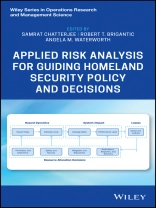Presents various challenges faced by security policy makers and risk analysts, and mathematical approaches that inform homeland security policy development and decision support
Compiled by a group of highly qualified editors, this book provides a clear connection between risk science and homeland security policy making and includes top-notch contributions that uniquely highlight the role of risk analysis for informing homeland security policy decisions. Featuring discussions on various challenges faced in homeland security risk analysis, the book seamlessly divides the subject of risk analysis for homeland security into manageable chapters, which are organized by the concept of risk-informed decisions, methodology for applying risk analysis, and relevant examples and case studies.
Applied Risk Analysis for Guiding Homeland Security Policy and Decisions offers an enlightening overview of risk analysis methods for homeland security. For instance, it presents readers with an exploration of radiological and nuclear risk assessment, along with analysis of uncertainties in radiological and nuclear pathways. It covers the advances in risk analysis for border security, as well as for cyber security. Other topics covered include: strengthening points of entry; systems modeling for rapid containment and casualty mitigation; and disaster preparedness and critical infrastructure resilience.
* Highlights how risk analysis helps in the decision-making process for homeland security policy
* Presents specific examples that detail how various risk analysis methods provide decision support for homeland security policy makers and risk analysts
* Describes numerous case studies from academic, government, and industrial perspectives that apply risk analysis methods for addressing challenges within the U.S. Department of Homeland Security (DHS)
* Offers detailed information regarding each of the five DHS missions: prevent terrorism and enhance security; secure and manage our borders; enforce and administer our immigration laws; safeguard and secure cyberspace; and strengthen national preparedness and resilience
* Discusses the various approaches and challenges faced in homeland risk analysis and identifies improvements and methodological advances that influenced DHS to adopt an increasingly risk-informed basis for decision-making
* Written by top educators and professionals who clearly illustrate the link between risk science and homeland security policy making
Applied Risk Analysis for Guiding Homeland Security Policy and Decisions is an excellent textbook and/or supplement for upper-undergraduate and graduate-level courses related to homeland security risk analysis. It will also be an extremely beneficial resource and reference for homeland security policy analysts, risk analysts, and policymakers from private and public sectors, as well as researchers, academics, and practitioners who utilize security risk analysis methods.
Inhoudsopgave
About the Editors
Contributors
Preface and Introduction
I. Managing National Security Risk and Policy Programs 10
1. On the ‘Influence of Scenarios to Priorities’ in Risk and Security Programs 10
Heimir Thorisson, James H. Lambert
2. Survey of Risk Analytic Guidelines Across the Government 25
Isaac Maya, Lily Doyle, Amelia Liu, Francine Tran, Robert Creighton, Charles Woo
3. An Overview of Risk Modeling Methods and Approaches for National Security 59
Samrat Chatterjee, Robert T. Brigantic, Angela M. Waterworth
4. Comparative Risk Rankings in Support of Homeland Security Strategic Plans 80
Russell Lundberg
5. A Data Science Workflow for Discovering Spatial Patterns Among Terrorist Attacks and Infrastructure 97
Daniel Fortin, Thomas Johansen, Samrat Chatterjee, George Muller, Christine Noonan
II. Strengthening Ports of Entry 117
6. Effects of Credibility of Retaliation Threats in Deterring Smuggling of Nuclear Weapons 117
Xiaojun Shan, Jun Zhuang
7. Disutility of Mass Relocation After a Severe Nuclear Accident 129
Vicki M. Bier, Shuji Liu
8. Scheduling Federal Air Marshals Under Uncertainty 153
Keith W. De Gregory, Rajesh Ganesan
III. Securing Critical Cyber Assets 171
9. Decision Theory for Network Security: Active Sensing for Detection and Prevention of Data Exfiltration 171
Sara M. Mc Carthy, Arunesh Sinha, Milind Tambe, Pratyusa Manadhatha
10. Measurement of Cyber Resilience from an Economic Perspective 193
Adam Z. Rose, Noah Miller
11. Responses to Cyber Near-misses: A Scale to Measure Individual Differences 210
Jinshu Cui, Heather Rosoff, Richard S. John
IV. Enhancing Disaster Preparedness and Infrastructure Resilience 225
12. An Interactive Web-Based Decision Support System for Mass Dispensing, Emergency Preparedness, and Biosurveillance 225
Eva K. Lee, Ferdinand H. Pietz, Chien-Hung Chen, Yifan Liu
13. Critical Infrastructure Risk Assessments: Measuring Critical Infrastructure Protection and Resilience in an All-Hazards Environment 243
Julia Phillips, Frédéric Petit
14. Risk Analysis Methods in Resilience Modeling: An Overview of Critical Infrastructure Applications 269
Hiba Baroud
5. Optimal Resource Allocation Model to Prevent, Prepare, and Respond to Multiple Disruptions, with Application to the Deepwater Horizon Oil Spill and Hurricane Katrina 284
Cameron A. Mac Kenzie, Amro Al-Kazimi
16. Inoperability Input-Output Modeling of Electric Power Disruptions 300
Joost R. Santos, Sheree Ann Pagsuyoin, Christian Yip
17. Quantitative Assessment of Transportation Network Vulnerability with Dynamic Traffic Simulation Methods 314
Venkateswaran Shekar, Lance Fiondella
18. Infrastructure Monitoring for Health and Security 327
Prodyot K. Basu
19. Exploring Metaheuristic Approaches for Solving the Traveling Salesman Problem Applied to Emergency Planning and Response 346
Ramakrishna Tipireddy, Javier Rubio-Herrero, Samrat Chatterjee, Satish Chikkagoudar, George Muller
Over de auteur
SAMRAT CHATTERJEE, Ph D, is Senior Operations Research/Data Scientist and the Decision Modeling and Optimization Team Lead in the Computing and Analytics Division within the National Security Directorate at Pacific Northwest National Laboratory (PNNL). He is also Affiliate Professor of Civil and Environmental Engineering with Northeastern University in Boston.
ROBERT T. BRIGANTIC, Ph D, is Chief Operations Research Scientist and the Statistical Modeling and Experimental Design Team Lead in the Computing and Analytics Division within the National Security Directorate at PNNL. He is also Adjunct Professor of Operations Research with the Carson College of Business at the Washington State University.
ANGELA M. WATERWORTH, MS, is Senior Operations Research/Data Scientist in the Computing and Analytics Division within the National Security Directorate at PNNL.












